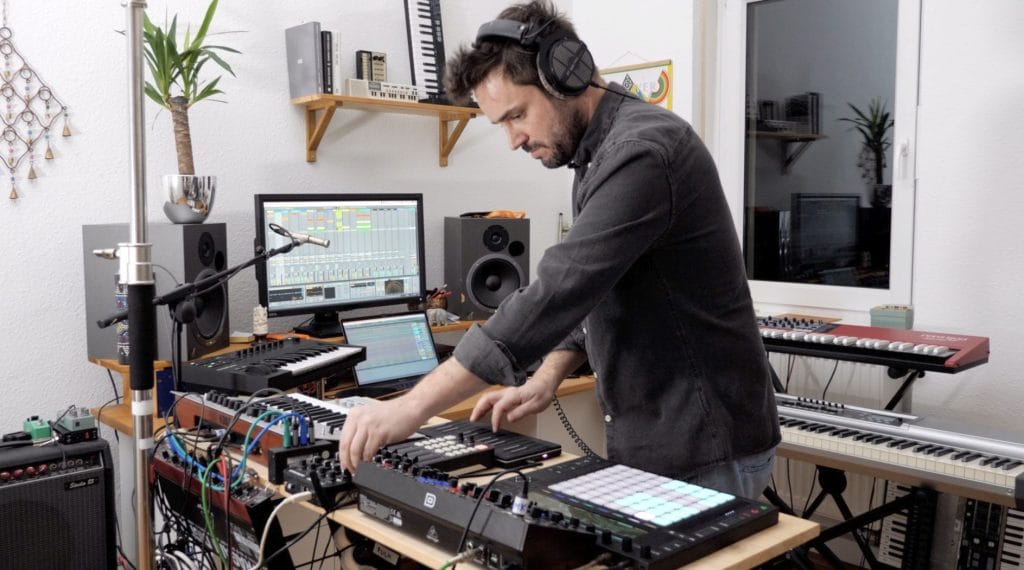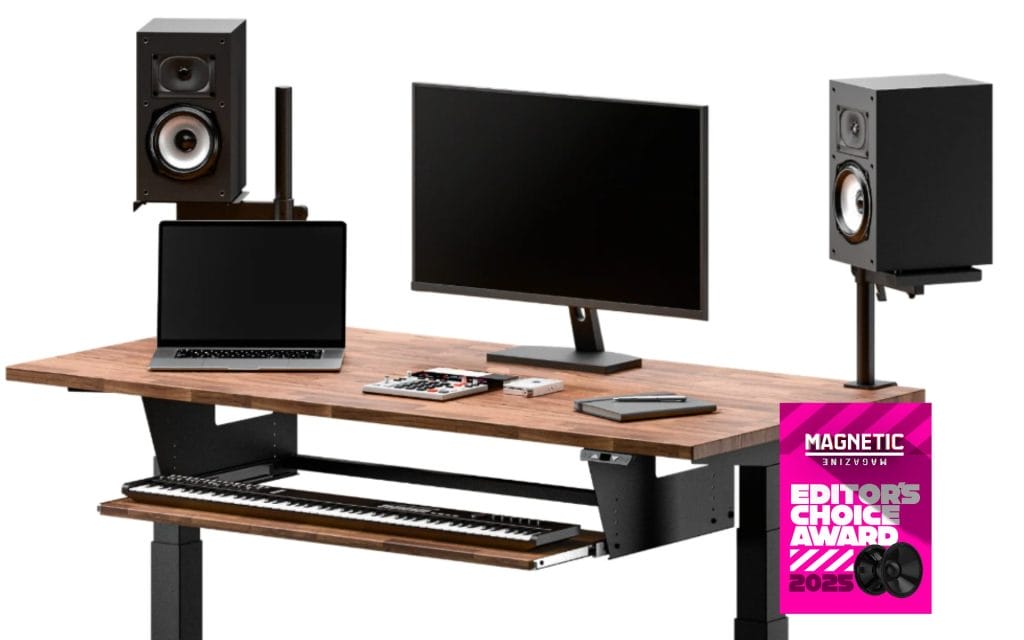Table of Contents
There are two types of studio desks: ones that try to look like they belong in a studio, and ones that are actually designed to function inside one. The Wavebone Starship falls squarely into the second category.
After months of daily use—including everything from DAW sessions and hardware jams to full workdays and Zoom calls—I can confidently say this is one of the most thought-out studio desks I’ve come across.
It’s not trying to reinvent anything. It’s just solving real problems: gear clutter, awkward ergonomics, and flimsy “studio-style” furniture that collapses under real-world use. The Starship nails the fundamentals: it’s stable, has excellent layout flexibility, and integrates a standing workflow without cutting corners.
Wavebone Starship Takes Home An Editor’s Choice Awards
The Wavebone Starship addresses core studio requirements directly—stability, real estate, and ergonomic control—while maintaining a high design standard that suits hybrid creative environments. Its role in daily work expands naturally, supporting both prolonged sitting and upright sessions with zero compromise to layout or accessibility.
For producers building a dedicated studio workflow that requires consistency, organization, and long-term reliability, the Starship serves as a clear foundational choice. Across real-world use cases, it meets expectations without needing to oversell its value. This desk earns an Editor’s Choice distinction based on merit, not marketing.
Full Loadout, Real Studio

This desk was tested with a high-density configuration: Ableton Push 3, a MIDI controller, a Korg desktop synth, studio monitors, and a wide-format ultra-HD display. A Hexcal desk shelf added additional elevation and structure for rear-row gear. Even with that entire loadout, the desktop remained comfortably functional, with space to work across multiple zones without overlap or interference.
However, weight distribution becomes a factor as the setup scales. Once heavier gear and additional synths were added, the dual-motor system returned an error and required a slight reduction in load. The manufacturer rates the lift capacity at 300 pounds, inclusive of the desk’s own mass.
That spec may appear sufficient on paper, but in actual use, the margin narrows quickly once full-sized monitors, synths, and a weighted keyboard come into play. The legs are mechanically sound, but producers with hybrid setups that lean toward hardware will need to stay aware of cumulative weight. A more detailed breakdown of the usable load limit—subtracting the desk’s surface weight—would be helpful during planning.

You also need to make sure that the weight is balanced on either side of the desk as many times I would get the weight-distribution error message when I would have a heavier piece of gear, like my Korg Minilogue, on the right and nothing to counter it on the left.
Still, once the gear count was adjusted and dsitributed slightly, the desk performed without issue. The platform remained structurally rigid, transition speeds were unaffected, and there was no sign of instability across the motor path or frame. In short, while the desk handles most configurations well, those building out maximalist hybrid rigs should account for total lift load from the beginning to avoid surprises mid-session.
Keyboard Tray
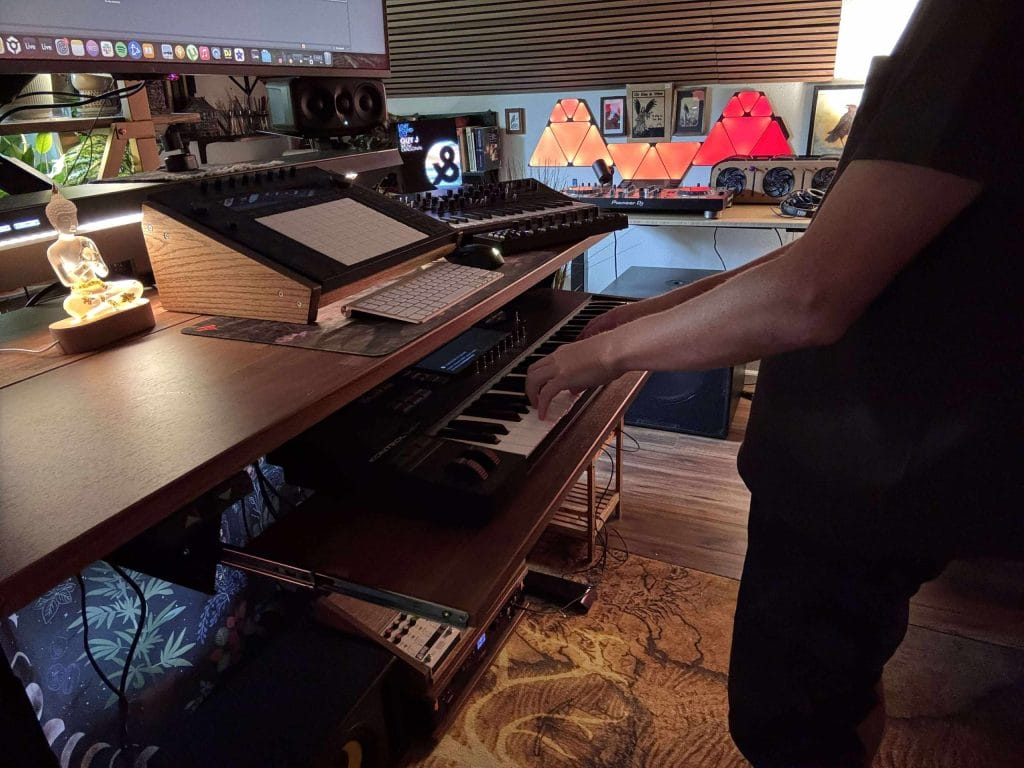
The keyboard tray is one of the best I’ve used. Mine holds a full-sized Native Instruments keyboard—one of the newer models with extra knobs and encoders—and the tray pulls out far enough for me to use it like a real instrument. I can see the OLED screen clearly, reach the encoders without leaning over, and play comfortably standing or sitting.
The glide is smooth. There’s no flex or instability. And it tucks completely out of the way when I don’t need it, which frees up the entire desk surface for modular jams or editing work.
Sit-Stand Integration
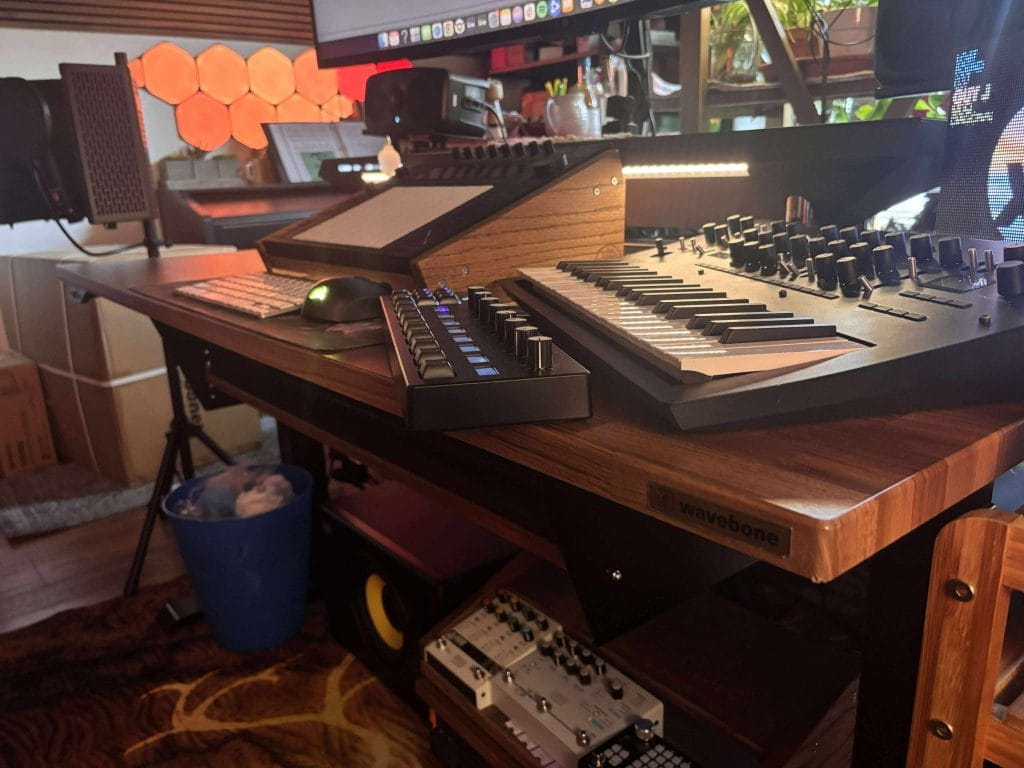
The sit-stand feature represents a practical response to how modern studios actually function. Music production rarely takes place in fixed blocks, and this desk supports that shift between modes without resistance. The dual motors activate quietly and precisely, and the four memory presets simplify the process of transitioning between stages of a session. Whether shifting posture for long edits or engaging differently with an instrument while standing, the movement feels fluid and reliable.
This flexibility has real implications for comfort and workflow. Users who spend full days at the desk—balancing sound design, remote meetings, and hardware sessions—gain from the ability to alternate posture without disrupting layout or reach. Standing to play a MIDI keyboard introduces a different energy into performance, while sitting to mix preserves focus and control. The desk structure allows for both, with no compromise to stability or alignment.
At full height, the frame remains rigid. No drift, no vibration, and no sagging across the central support. That structural consistency supports confidence in using the desk not only as a workspace but as a foundation for high-value equipment. For studios operating in compact rooms or hybrid living spaces, this stability becomes a core requirement, not a bonus. The Starship meets that requirement directly, offering physical reliability alongside the ergonomic adaptability producers increasingly expect from their environments.
Layout and Space
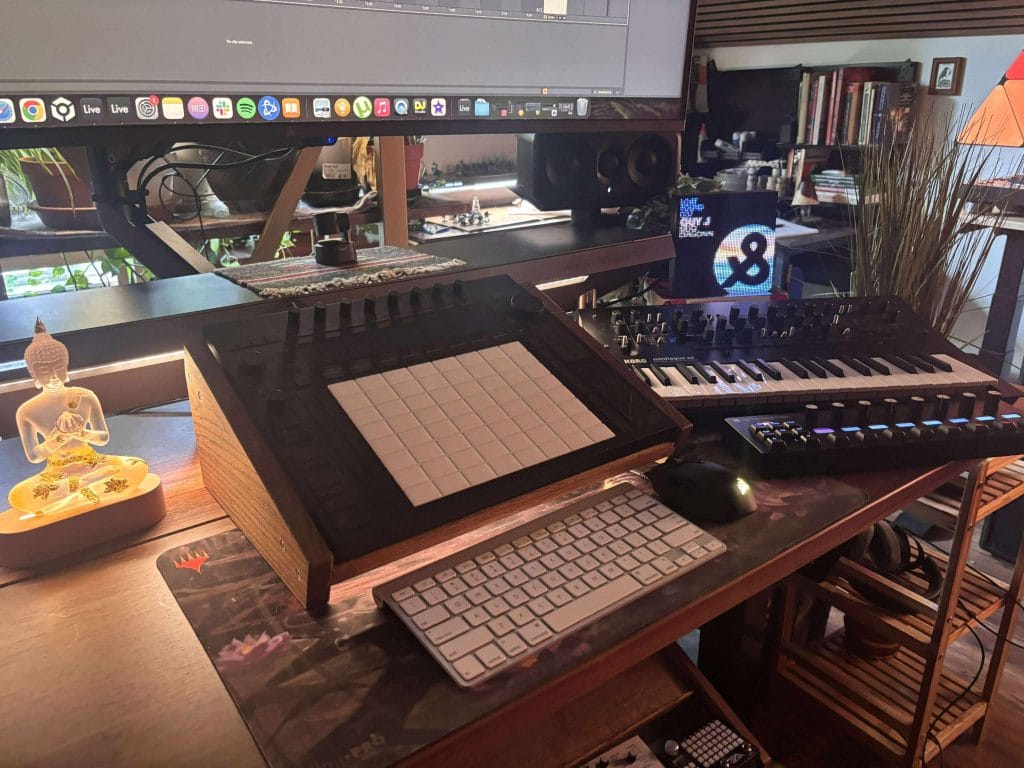
Space is what determines whether a desk can support actual production work versus simply holding equipment. The Starship accommodates real workflows without forcing compromises. With the keyboard tray positioned to handle a full-sized controller, the main surface remains unobstructed, leaving more room for focused tasks. Synths, touch devices, trackpads, notebooks, and reference materials can all exist within immediate reach without competing for position.
This allows for setups that reflect how modern producers work—not just in terms of gear footprint, but in how often tools are rotated in and out depending on the task. Rather than managing congestion by sacrificing accessibility, the desk’s surface area enables a distributed layout where nothing overlaps or bottlenecks. For producers running hybrid environments—balancing analog hardware, modular gear, and digital control surfaces—this level of layout freedom becomes a baseline requirement, not a luxury.
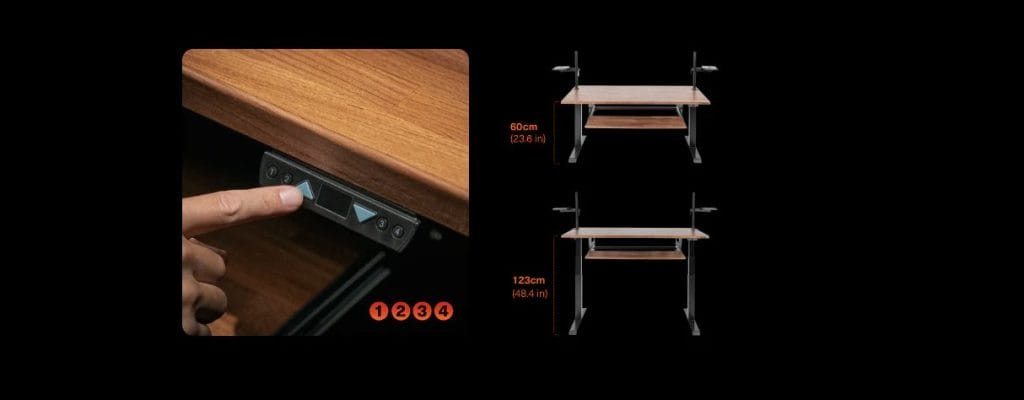
Sturdy construction reinforces that flexibility. The desk responds to weight and reach with full stability. No sag, no flex, no subtle shifting when leaning in or making gear adjustments. That structural consistency allows for faster movement during patching or live manipulation, without fear of disrupting other equipment in the process.
Layout also ties into time management. The fewer adjustments required between modes of work, the more uninterrupted hours can be spent focusing on actual sound development. And this becomes more relevant when shifting from design tasks into mix prep, or transitioning from production into playback and evaluation. A flat, wide desk with no spatial compromises supports that movement.
The Starship does not dictate a specific layout philosophy. It simply provides enough real estate and strength to support whatever workflow a producer has built, regardless of how much gear is involved. That alone separates it from most furniture marketed toward music creators.
Build Quality and Assembly
Assembly was clean and unproblematic. The hardware arrives logically packed, and nothing feels underbuilt or improvised. One person can handle the full setup without issue, though aligning the frame might go quicker with a second set of hands. The instructions avoid guesswork, and the parts themselves—rails, bolts, fasteners—lock into place without forcing adjustments. No gaps, no misfit corners, no strange tolerances that require over-tightening. It builds like something meant to be lived with, not rotated out.
Once in place, the desk holds its form with clarity. The 25mm top has a solid mass to it that keeps flex and bowing out of the equation entirely. Even with weight placed toward the edge—monitors, gear stands, a full control surface—there’s no bend or give. The frame handles vertical load without noise or drift. That level of physical reliability translated into practical confidence when I was using it.
Aesthetically, the walnut finish lands in a category few desks hit: neutral without feeling clinical.
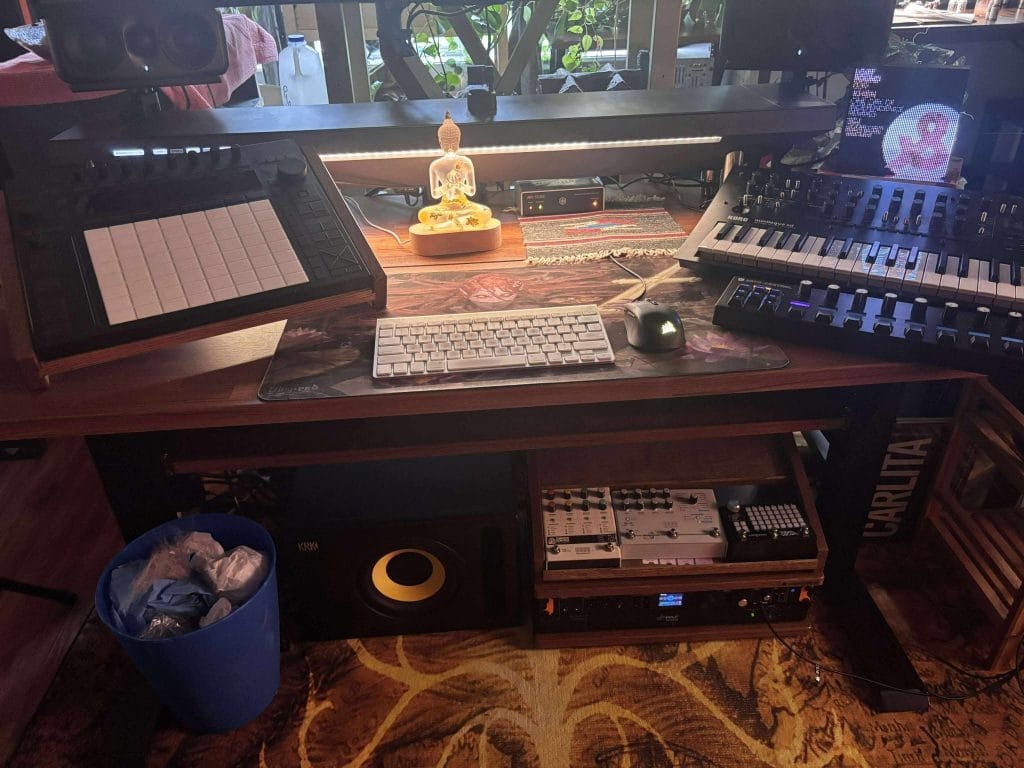
The surface reflects minimal light, which matters under screens or LED backlights. The tone sits comfortably between modern and organic, so it avoids clashing with typical studio setups that blend foam panels, lighting strips, and gear with wildly different finish types. In a full room with actual use cases, the Starship reads clean and intentional, without drawing attention to itself. The online images show the shape and color well enough, but the texture and grain come through better in person—especially in a space built for focus.
All of this adds up to a build that feels engineered for permanent use. The desk does not ask to be babied. It was designed to stay in place and support the kind of work that tends to stretch across weeks, months, and projects.
Taken as a whole, the build quality reinforces the main premise: this is studio furniture designed to support actual music-making, not just visual staging.
Daily Use

Over time, a few things stood out that made this desk hold its place in a real workflow. First was the way it handled space. With the keyboard tray supporting a full-sized controller, the main surface stayed clear and usable. Gear had a place, and once it was set, it stayed there. There was no need to constantly reshuffle or unplug things just to switch tasks. That alone cut down on the small interruptions that tend to stack up over a long day.
The standing function also started to shape how the space got used. Playing keys upright felt more immediate, almost like being on stage, while sitting helped lock in for mix decisions and detailed edits. That shift between postures didn’t require a reset—it just happened when it needed to. The desk supported both modes without losing alignment or access.
None of this felt like a feature being pushed. It worked because the structure gave everything room to breathe.
No extra attachments…
No workaround tools…
Just solid design that kept up with the demands of back-to-back sessions. That consistency allowed for actual momentum. The less time spent adjusting the desk, the more time could go into finishing tracks, tweaking ideas, or just getting through the day without friction. For a studio that runs long hours across multiple types of work, that kind of stability ends up being one of the most valuable features.
One Area for Improvement
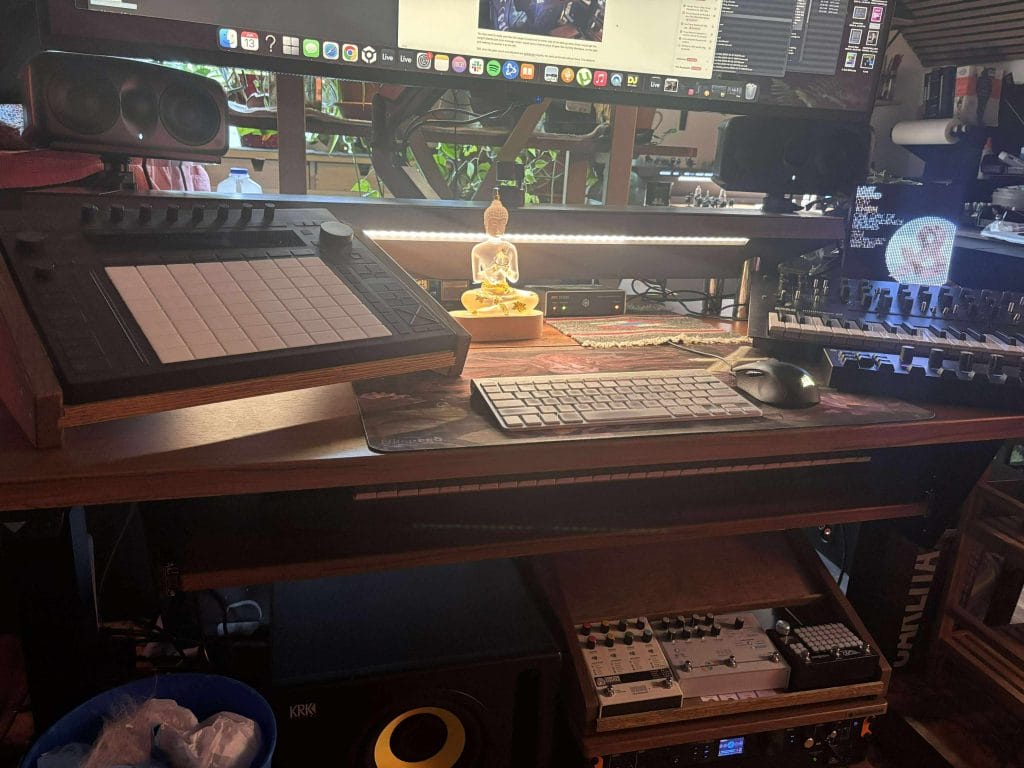
The lift system is rated for 300 pounds, which includes the weight of the surface panels and structural frame. This means the practical payload for gear is lower than the headline number might suggest. With a dense setup involving an ultrawide display, nearfield monitors, hardware synths, and a weighted keyboard, the margin tightens quickly. Once that threshold is exceeded, the motors respond by disabling lift function to protect the drive system—a safeguard that signals the desk’s engineering is reliable, though the communicated specs could benefit from more precision.
Wavebone could strengthen the product experience by listing the net lift load available after assembly. That level of transparency would assist users in calculating safe configurations ahead of time, especially for studios running gear-heavy workflows.
Despite this edge case, the desk performed without fault once the gear load was slightly reduced. Transition performance remained smooth, and structural integrity was preserved across the full range of motion. The desk never indicated strain or instability, even at full extension under near-maximum load.
Conclusion
The Wavebone Starship Studio Standing Desk delivers where it matters. It prioritizes stability, layout flexibility, and long-term usability without introducing complexity or visual clutter. Every component—whether the glide on the keyboard tray, the motor consistency, or the structural finish—reinforces a commitment to daily, real-world functionality.
The standing workflow supports task switching without interruption. The desk holds its shape under real gear weight. And it integrates visually into studio spaces focused on productivity rather than staged aesthetics. These qualities add up over time, creating a workspace that stays useful session after session.
For producers looking to build a focused, ergonomic, and adaptable studio setup, the Starship holds up across the board. There are no weak points in its design or execution. It supports modern production demands while staying grounded in practical decisions. This recognition is not given lightly—the desk earns its Editor’s Choice title through tested, consistent performance. It is a product that meets professional standards without needing to be dressed up to feel convincing.
The post Wavebone Starship™ Review – The Best Studio Desk for Sit-Stand Workflow appeared first on Magnetic Magazine.




